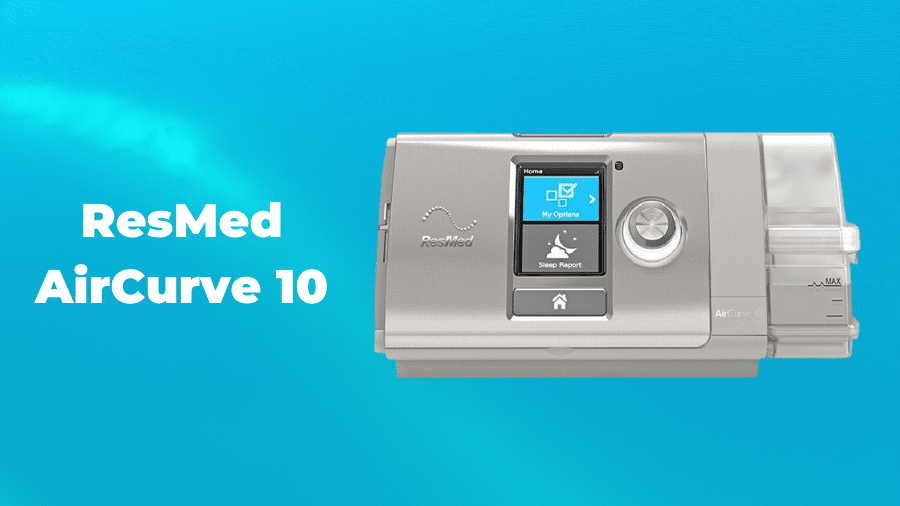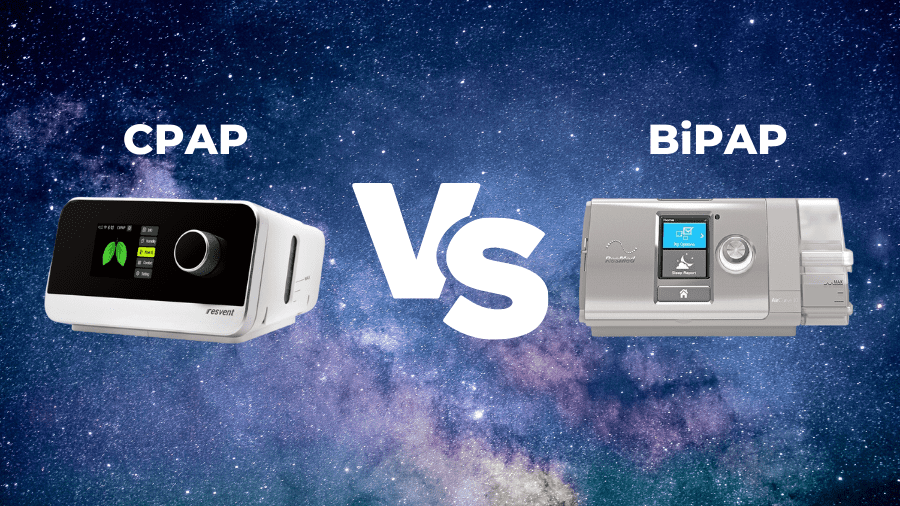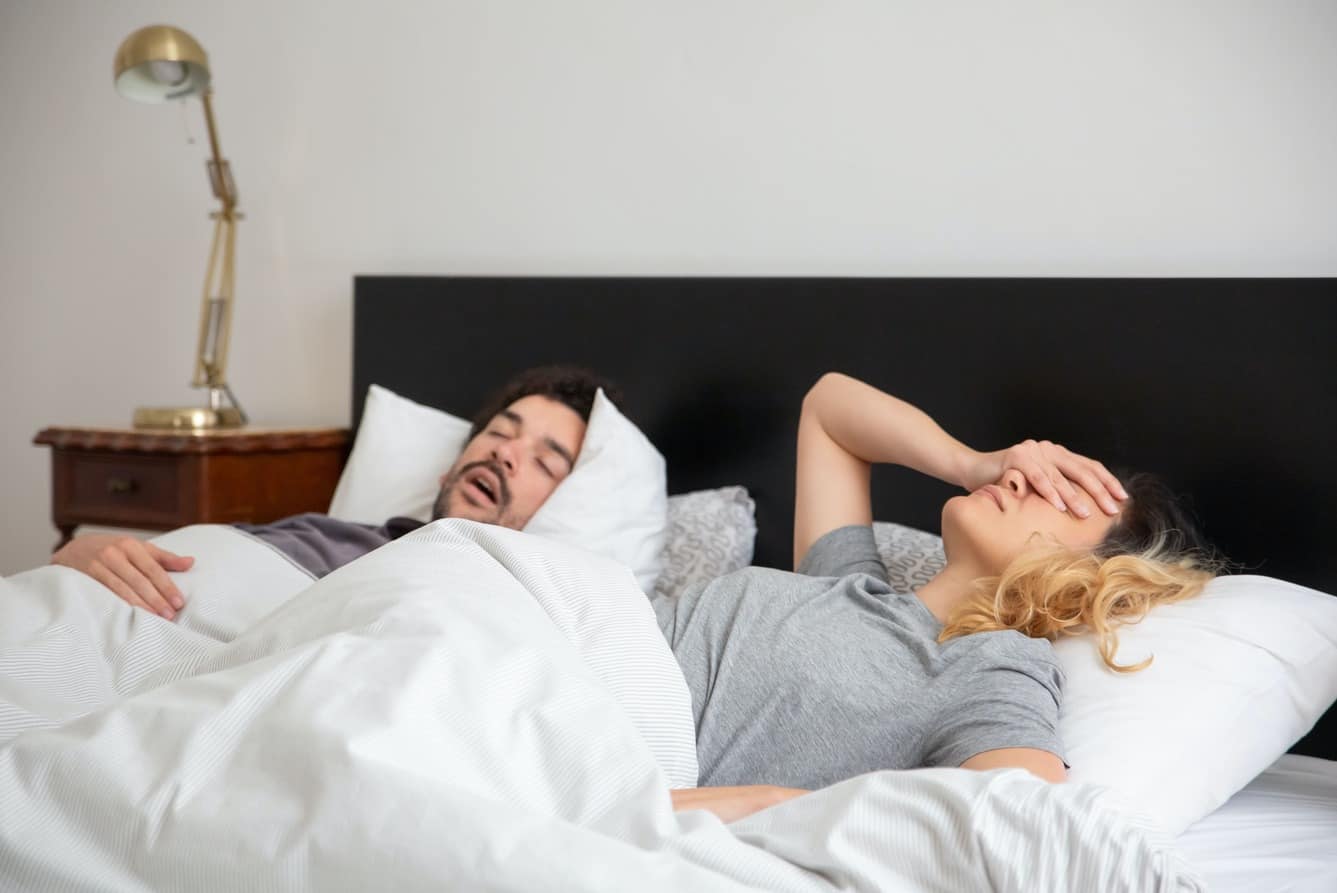CPAP and BiPAP machines differ in the way air pressure is applied. In a manual CPAP, pressure is set to a constant rate. A step-up is an APAP machine that can increase or decrease the amount of pressure. And BiPAP machines offer two levels of air pressure – one for inhaling and one for exhaling.
Today, we are going to talk about the differences between a CPAP and a BiPAP machine. Specifically, we will discuss the nuts and bolts of how both of these types of machines actually work to treat sleep apnea, the differences between manual CPAP, automatic CPAP, and BiPAP devices, and why you might want to use one over the other.
We’ll finish by taking a quick look at some of the most popular models on the market today in both the CPAP and BiPAP categories, including their features and costs. So let’s get into it!
Sleep Apnea and CPAP Prescription
Let’s set the scene by talking about sleep apnea in general. Sleep apnea is a sleeping disorder in which breathing repeatedly stops and starts.
Obstructive sleep apnea, the most common form of sleep apnea, occurs when the muscles at the back of your throat relax. When the muscles relax, then your airway narrows or even closes as you breathe in – which in turn means that you don’t inhale enough air.
Your brain senses this closure and briefly wakes you up in order to reopen the airway. This process is usually so quick that you don’t even remember it, but for someone suffering from sleep apnea, this could be happening anywhere from 5-30 times an hour all night long, every single night. This prohibits you from having deep, restful phases of sleep.
Symptoms of sleep apnea could include snoring loudly, waking up regularly with a headache and dry mouth, or even waking up gasping for breath.
Or, if you have difficulty staying asleep (insomnia) or excessive daytime sleepiness (hypersomnia), and you don’t have a newborn in the house, then you should consider getting a sleep study done.
You can undergo a sleep study either through your clinic or by taking the In-Home Sleep Study available at Respshop.com. Either way, once you have completed the study, you’ll need to have your doctor provide you with a prescription in order to purchase a CPAP, BiPAP, or any other positive air pressure device.
CPAP Options – CPAP, BiPAP, APAP, etc
Now, let’s assume that you have your prescription in hand and are in the market to purchase your first device. Great! Now what?
It can be daunting when you look at the number of options available to you. There’s CPAP, BiPAP, APAP, and VPAP, not to mention the accessories to go with them, such as humidifiers, masks, and hoses.
Before you know it, it can begin to sound more like you are equipping yourself to work in a nuclear reactor rather than simply wanting a good night’s sleep.
But fear not! Let’s break down how each type of device works so you can determine the best fit for your needs, and the best way to do this is to start by focusing on what all of the machine types have in common, and that is the ‘PAP’ part of their name.
What ‘PAP’ Stands For
Whether we’re talking CPAP, BiPAP, APAP… or any other PAP, the ‘PAP’ portion of the name stands for Positive Air Pressure.
With all of these machine types, pressurized air is generated via a compressor within the unit housing, which then travels through an air filter, up the hose, and into a cushioned mask.
The mask may cover just your nostrils, your whole nose, or it can be a full mask that is shaped like a triangle and covers your nose and mouth. Most machines also include a humidifier that prevents your nose and mouth from drying out.
Manual vs Auto CPAP
The most common type of Positive Air Pressure machine is a CPAP machine. The C of CPAP stands for Continuous. So, a CPAP machine is a machine that provides this positive air pressure, continuously.
Effectively, the machine pushes a gentle but steady flow of air into your nose and mouth as you sleep. This keeps your airway open and helps you breathe normally.
A CPAP machine is usually prescribed for those with obstructive sleep apnea or infants whose lungs have not fully developed. Within the category of CPAP machines, there could be either what we at Respshop would describe as a manual CPAP machine or an Auto CPAP.
In a manual CPAP, the amount of air pressure delivered is dictated by the machine settings and is set to a constant rate.
An automatic CPAP machine, also known as an APAP machine, can detect whether an airway is open or closed by measuring resistance. Then, it can increase or decrease the amount of pressure necessary to resolve sleep apnea.
This means that the APAP delivers the minimum amount of pressure necessary where possible. Both automatic and manual CPAP machines are often described under the umbrella term of simply ‘CPAP machines.’
The BiPAP Machine
The ‘Bi’ of BiPAP stands for Bilevel. These machines work in much the same way as a CPAP device would, except there are two levels of air pressure – one for inhaling and one for exhaling.
These machines also monitor the number of breaths per minute (BPM) the user is taking and may be set to deliver a breath when needed so that a minimum BPM is met.
BiPAP machines are often prescribed to those who need extra respiratory support or for patients with additional conditions, such as congestive heart failure or neurological medical disorders.
BiPAP machines are typically more expensive and are often recommended when users struggle with the continuous pressure of CPAP as the bilevel pressure of BiPAP decreases strain on the body during exhalation. Put simply, BiPAP machines make it easier to breathe out.
APAP and BiPAP Machine Examples
When you are purchasing any type of machine, typically everything you need to get started will come included in the box – except the mask, because there are different options for those.
Resvent iBreeze Auto CPAP
The new Resvent iBreeze is an Auto CPAP machine. This is the updated model to an already popular line and is a great option for those who want a simple-to-use device with some great automation features that will give you an excellent experience out of the box.
The screen is bright and easy to read, navigation is simple, and the device is rated at 30 dBA, which is as quiet as a ticking clock or soft whisper. Respshop.com currently has these on a great intro price, which makes them a great option as a secondary, or backup machine.
ResMed AirCurve 10 VPAP

The ResMed AirCurve 10 is a premier VPAP machine and represents the top-of-the-line among bi-level devices.
Don’t be thrown off when we say ‘VPAP’ instead of ‘BiPAP.’ VPAP and BiPAP are the same things. BiPAP was a term owned by Respironics, which was acquired by Phillips, and so ‘VPAP’ is simply the ResMed brand name for the same technology.
Like all BiPAP devices, the AirCurve is designed to make breathing with a PAP device as comfortable as possible.
It offers such features as Automatic Bi-Level Treatment, which will have the pressure at its most comfortable level but can determine when the user is having a respiratory disturbance and adjust the pressure accordingly.
Another feature is Expiratory Pressure Relief (EPR), which decreases pressure at the onset of each breath.
BiPAP units typically have a greater amount of technology and therefore cost more. Respshop is your go-to online retailer for some of the most competitive pricing available as well as a wealth of information from industry experts.
So contact us today if you have any questions about any of the units we sell, or to discuss your sleep therapy.
Well, we hope you learned something about the differences between these machines. Comment below if you already own a PAP machine and let us know what you do or don’t like about it.
And, wherever you are, sleep tight! Until next time.






